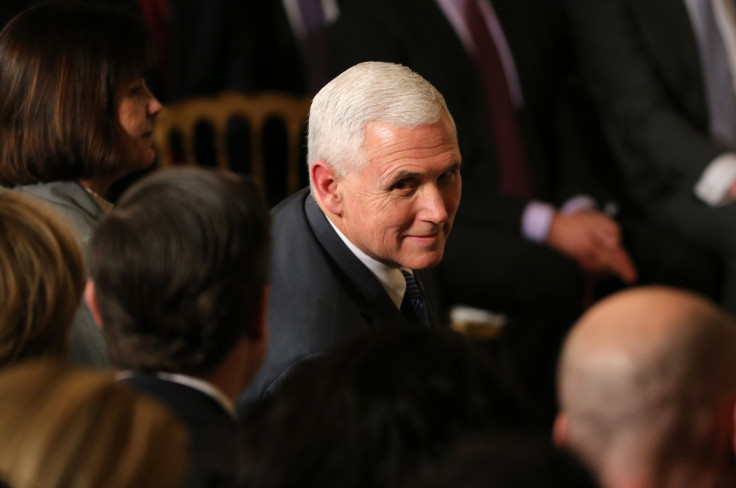Pence Putsch: Is there a Republican plot to unseat Donald Trump using the 25th Amendment?
US constitution allows for the president to be replaced if unable to carry out duties of his office.

Republicans have forgiven a lot of Donald Trump during his tumultuous nomination battle, vitriolic campaign and controversial first few weeks in the White House, but this latest scandal may be a bridge too far.
The allegations of links between his administration and Vladimir Putin's Russia have shocked Democrats and Republicans alike, and Trump will need more than a few tax breaks and a uber-conservative Supreme Court nomination to retain his support in Republican-controlled Congress and the Senate if they turn out to be true.
But what could Republicans in the Senate and the House of Representatives do if they finally decide that Trump's erratic behaviour is endangering America at large? For some, that answer lies in Mike Pence, the vice-president and the man most conservative Republicans would have preferred to see in the White House all along.
What is the 25<sup>th Amendment?
The first three clauses of the 25<sup>th Amendment are designed to provide for an orderly succession in the event that a president dies, resigns or is incapacitated in office. It has been used a number of times, including when John F. Kennedy was shot dead in 1963 and replaced by his vice-president, Lyndon B. Johnson.
Then in 1974 the 25<sup>th was enacted to allow Gerald Ford to take over as president following the resignation of Richard Nixon after the Watergate scandal. In 2002 and 2007, George W. Bush used the amendment to give power to his vice-president, Dick Cheney, for two periods of around 24 hours while he underwent a colonoscopy.
But there is a fourth clause to the Amendment, which provides for a situation when the vice-president and the majority of the cabinet believe the president to be unable to carry out his/her duties (and it has always been a he) office. If they do so, the motion goes to Congress, who have 21 days to decide by a two-thirds majority.
Has it ever been used to unseat a president?
No, and it is unclear exactly how it would work. The amendment does not define what constitutes "unable to carry out the duties of office", and would undoubtedly lead to a bitter constitutional battle that would consume the US for months, if not years. It also gives the president the right to appeal the motion, which Trump would likely do.
But while the amendment has never been applied in the real world, it is frequently the subject of TV shows and movies. Who could forget season two of TV show 24, when President David Palmer is removed from office by his cabinet under the 25<sup>th Amendment and his vice-president, Jim Prescott is sworn in.
Would it work?
The Republicans never wanted Donald Trump as their candidate and although he has tried to appeal to them with classic GOP stances on abortion, gun rights, Medicare and Iran, many could begin to be worried as they approach the mid-terms in 2018 with a president it would be fair to describe as "a loose cannon".
But in reality, most Republicans would likely side with Trump and unless the Democrats can take back the Senate or the House in 2018, that is unlikely to change. There is also no guarantee that Pence – or indeed his cabinet – would back an unprecedented attempt to unseat a democratically elected president.
The 25th Amendment
SECTION 1: In case of the removal of the President from office or of his death or resignation, the Vice President shall become President.
SECTION 2: Whenever there is a vacancy in the office of the Vice President, the President shall nominate a Vice President who shall take office upon confirmation by a majority vote of both Houses of Congress.
SECTION 3: Whenever the President transmits to the President pro tempore of the Senate and the Speaker of the House of Representatives his written declaration that he is unable to discharge the powers and duties of his office, and until he transmits to them a written declaration to the contrary, such powers and duties shall be discharged by the Vice President as Acting President.
SECTION 4: Whenever the Vice President and a majority of either the principal officers of the executive departments or of such other body as Congress may by law provide, transmit to the President pro tempore of the Senate and the Speaker of the House of Representatives their written declaration that the President is unable to discharge the powers and duties of his office, the Vice President shall immediately assume the powers and duties of the office as Acting President. Thereafter, when the President transmits to the President pro tempore of the Senate and the Speaker of the House of Representatives his written declaration that no inability exists, he shall resume the powers and duties of his office unless the Vice President and a majority of either the principle officers of the executive department or of such other body as Congress may by law provide, transmit within four days to the President pro tempore of the Senate and the Speaker of the House of Representatives their written declaration that the President is unable to discharge the powers and duties of his office.
Thereupon Congress shall decide the issue, assembling within forty- eight hours for that purpose if not in session. If the Congress within twenty-one days after receipt of the latter written declaration, or, if Congress is not in session within twenty-one days after Congress is required to assemble, determines by two- thirds vote of both Houses that the President is unable to discharge the powers and duties of his office, the Vice President shall continue to discharge the same as Acting President; otherwise, the President shall resume the powers and duties of his office.
© Copyright IBTimes 2025. All rights reserved.






















